| Revision as of 05:43, 8 December 2019 editMikhail Ryazanov (talk | contribs)Extended confirmed users23,633 editsm →Gallery: fmt. (less wasted space)← Previous edit | Revision as of 05:49, 8 December 2019 edit undoMikhail Ryazanov (talk | contribs)Extended confirmed users23,633 editsm →top: punct., fmt.Next edit → | ||
| Line 1: | Line 1: | ||
| ] | ] | ||
| This is a '''list of ]s by country of origin'''. This list excludes cars over 700 cc |
This is a '''list of ]s by country of origin'''. This list excludes cars over 700 cc and cars where production or manufacture ended before 1945. | ||
| Microcars have been defined as |
Microcars have been defined as "very compact, small-engined cars, designed for use in large cities, especially in Japan".<ref>{{cite book | ||
| | last = Schwarz |
| editor-last = Schwarz | ||
| | first = Catherine | | editor-first = Catherine | ||
| | coauthors = | |||
| | title = The Chambers Dictionary | | title = The Chambers Dictionary | ||
| | publisher = Chambers | | publisher = Chambers | ||
| | year = 1994 | | year = 1994 | ||
| | isbn = 0-550-10255-8}}</ref> even though in Japan |
| isbn = 0-550-10255-8}}</ref> even though in Japan such cars are known as ]s. | ||
| Microcars have also been defined as being a |
Microcars have also been defined as being a "small car, popular in the 1950s, that featured a body offering full weather protection and mechanics often derived from motorcycle technology",<ref>{{cite book | ||
| ⚫ | | |
||
| | first = | |||
| | coauthors = | |||
| | title = Dictionary of Automobile Engineering | | title = Dictionary of Automobile Engineering | ||
| | publisher = Peter Collin Publishing | | publisher = Peter Collin Publishing | ||
| | year = 1996 | | year = 1996 | ||
| | isbn = 0-948549-66-1 | | isbn = 0-948549-66-1 | ||
| ⚫ | | author = | ||
| | |
| editor = English edition editorial team, Rupert Livesey, Robin Sawers, Liz Greasby ; advisor, Dave Whitehouse}}</ref> | ||
| though in the 1950s, a trend towards egg-shaped cars with a relatively large ratio of windows to bodywork meant that the affectionate term ] was used.<ref>{{Cite news | though in the 1950s, a trend towards egg-shaped cars with a relatively large ratio of windows to bodywork meant that the affectionate term ] was used.<ref>{{Cite news | ||
| | publication-date=April 1963 | | publication-date=April 1963 | ||
| Line 26: | Line 23: | ||
| | publication-place=] | | publication-place=] | ||
| | pages=34–35 | | pages=34–35 | ||
| | postscript= |
| postscript=. | ||
| }}</ref> | }}</ref> | ||
| The term microcar is usually applied only to such small ] |
The term microcar is usually applied only to such small ] built after ]; cars built prior to the war are more generally referred to as ]s. However, one dictionary definition states simply that a microcar is "a small fuel-efficient automobile".<ref>{{cite web | year = 2007 | url = http://dictionary.reference.com/browse/microcar| title = Webster’s New Millennium Dictionary of English | format = Preview Edition (v 0.9.7) | work = | publisher = Dictionary.com | accessdate = 2007-09-16}}</ref> | ||
| An attempt at a more specific definition for microcars suggested by some enthusiasts is |
An attempt at a more specific definition for microcars suggested by some enthusiasts is "economy vehicles with either three or four wheels, powered by petrol engines of no more than 700 cc or battery electric propulsion, and manufactured since 1945".<ref>{{cite web | year = 2007 | url = http://www.rumcars.org/a-about.html | title = About RUM | work = | publisher = The Register of Unusual Microcars | accessdate = 2007-09-14}}</ref> | ||
| In short, defining what is or what is not a microcar is not an exact science. Microcar is a subjective common ], so no list will ever be definitive. But with museums devoted solely to microcars,<ref>{{cite web |
In short, defining what is or what is not a microcar is not an exact science. Microcar is a subjective common ], so no list will ever be definitive. But with museums devoted solely to microcars,<ref>{{cite web | year = 2007 | url = http://www.microcarmuseum.com/ | title = The Bruce Weiner Microcar Museum | format = | work = | publisher = microcarmuseum.com | accessdate = 2007-09-30}}</ref><ref>{{cite web | year = 2007 | url = http://www.bubblecarmuseum.co.uk/ | title = The Bubble Car Museum | format = | work = | publisher = bubblecarmuseum.co.uk | accessdate = 2007-09-30}}</ref> numerous published encyclopaedias of microcars<ref>{{cite book | ||
| | last = Rees | | last = Rees | ||
| | first = Chris | | first = Chris | ||
| | coauthors = | |||
| | title = Microcar Mania | | title = Microcar Mania | ||
| | publisher = Bookmarque Publishing | | publisher = Bookmarque Publishing | ||
| Line 43: | Line 39: | ||
| | last = Dan | | last = Dan | ||
| | first = Michael | | first = Michael | ||
| ⚫ | | title = A–Z of Popular Scooters and Microcars | ||
| | coauthors = | |||
| ⚫ | | title = |
||
| | publisher = Bookmarque Publishing | | publisher = Bookmarque Publishing | ||
| | year = 2007 | | year = 2007 | ||
Revision as of 05:49, 8 December 2019

This is a list of microcars by country of origin. This list excludes cars over 700 cc and cars where production or manufacture ended before 1945.
Microcars have been defined as "very compact, small-engined cars, designed for use in large cities, especially in Japan". even though in Japan such cars are known as kei cars. Microcars have also been defined as being a "small car, popular in the 1950s, that featured a body offering full weather protection and mechanics often derived from motorcycle technology", though in the 1950s, a trend towards egg-shaped cars with a relatively large ratio of windows to bodywork meant that the affectionate term bubble car was used.
The term microcar is usually applied only to such small cars built after World War II; cars built prior to the war are more generally referred to as cyclecars. However, one dictionary definition states simply that a microcar is "a small fuel-efficient automobile".
An attempt at a more specific definition for microcars suggested by some enthusiasts is "economy vehicles with either three or four wheels, powered by petrol engines of no more than 700 cc or battery electric propulsion, and manufactured since 1945".
In short, defining what is or what is not a microcar is not an exact science. Microcar is a subjective common noun, so no list will ever be definitive. But with museums devoted solely to microcars, numerous published encyclopaedias of microcars and microcar enthusiast clubs worldwide, this list is an attempt to collate as many of these vehicles as possible into a common grouping.
List of microcars by country of origin
| This list is incomplete; you can help by adding missing items. (October 2019) |
Gallery
- Microcar gallery
-
 Aixam 400
Aixam 400
-
 Alta A200
Alta A200
-
 Attica 200
Attica 200
-
 Attica DIM 652
Attica DIM 652
-
 Autobianchi Bianchina Transformabile Special
Autobianchi Bianchina Transformabile Special
-
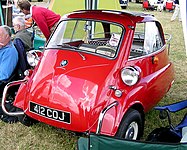 BMW Isetta 300
BMW Isetta 300
-
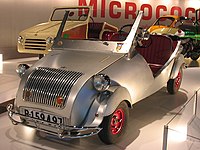 Biscúter 100
Biscúter 100
-
 Biscúter Comercial 200C
Biscúter Comercial 200C
-
 Bond Bug
Bond Bug
-
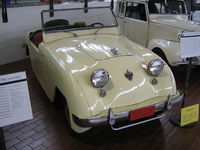 Crosley Super Sport
Crosley Super Sport
-
Daihatsu Mira 7th Generation
-
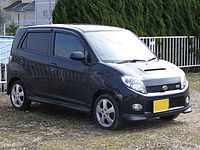 Daihatsu Fellow Max
Daihatsu Fellow Max
-
 Daihatsu Bee
Daihatsu Bee
-
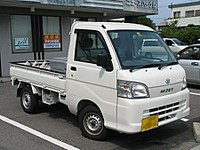 Daihatsu Hijet/Piaggio Porter
Daihatsu Hijet/Piaggio Porter
-
 David Torpedo 2 S
David Torpedo 2 S
-
CityEl
-
 Fiat 500 Topolino
Fiat 500 Topolino
-
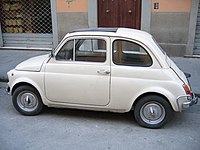 Fiat 500
Fiat 500
-
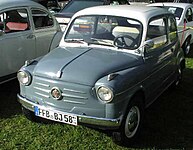 Fiat 600
Fiat 600
-
 Fiat 600 Multipla
Fiat 600 Multipla
-
 Polski Fiat 126p
Polski Fiat 126p
-
 Fram King Fulda (1957)
Fram King Fulda (1957)
-
Goggomobil Dart
-
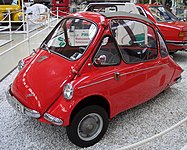 Heinkel Kabine
Heinkel Kabine
-
 Honda N Sedan
Honda N Sedan
-
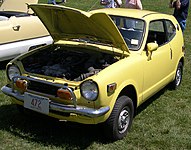 Honda Z Coupe
Honda Z Coupe
-
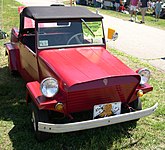 King Midget Model III
King Midget Model III
-
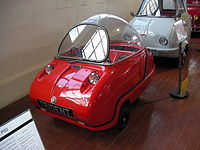 Peel Trident
Peel Trident
-
 Peel P50
Peel P50
-
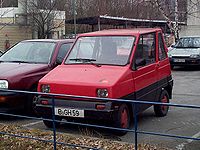 Puli
Puli
-
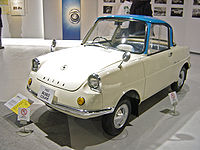 Mazda R360 coupe
Mazda R360 coupe
-
 Messerschmitt Kabinenroller
Messerschmitt Kabinenroller
-
 Mitsubishi Minica 1st Generation
Mitsubishi Minica 1st Generation
-
 Post facelift Reliant Robin Saloon
Post facelift Reliant Robin Saloon
-
 Sebring Vanguard Citicar
Sebring Vanguard Citicar
-
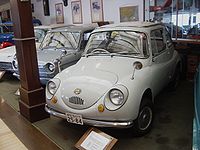 Subaru 360
Subaru 360
-
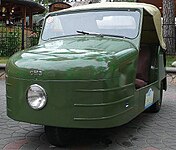 Soviet SMZ S-1L
Soviet SMZ S-1L
-
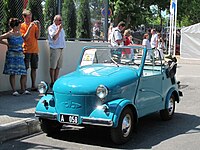 SMZ S-3A
SMZ S-3A
-
 SMZ S-3D
SMZ S-3D
-
ZAZ-965
See also
References
- Schwarz, Catherine, ed. (1994). The Chambers Dictionary. Chambers. ISBN 0-550-10255-8.
- English edition editorial team, Rupert Livesey, Robin Sawers, Liz Greasby ; advisor, Dave Whitehouse, ed. (1996). Dictionary of Automobile Engineering. Peter Collin Publishing. ISBN 0-948549-66-1.
{{cite book}}:|editor=has generic name (help)CS1 maint: multiple names: editors list (link) - "65 MPH and 80 MPG-That's the Messerschmitt". Motorcycle Mechanics. London (published April 1963). 1963. pp. 34–35.
{{cite news}}: CS1 maint: postscript (link) - "Webster's New Millennium Dictionary of English" (Preview Edition (v 0.9.7)). Dictionary.com. 2007. Retrieved 2007-09-16.
- "About RUM". The Register of Unusual Microcars. 2007. Retrieved 2007-09-14.
- "The Bruce Weiner Microcar Museum". microcarmuseum.com. 2007. Retrieved 2007-09-30.
- "The Bubble Car Museum". bubblecarmuseum.co.uk. 2007. Retrieved 2007-09-30.
- Rees, Chris (1995). Microcar Mania. Bookmarque Publishing. ISBN 1-870519-18-3.
- Dan, Michael (2007). A–Z of Popular Scooters and Microcars. Bookmarque Publishing. ISBN 978-1-84584-088-4.